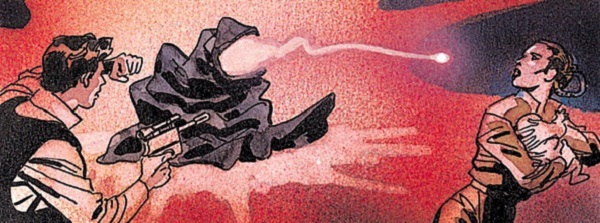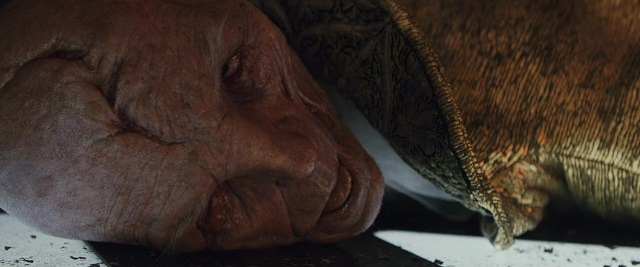
After a lengthy dry spell, welcome back to Escape Pod, our recurring series in which we choose one thing from Legends and argue for its inclusion in the new canon.
When Obi-Wan Kenobi first stated “if you strike me down, I shall become more powerful than you can possibly imagine”, there was next to nothing explaining what that actually meant—even after we’d heard his voice in Luke’s head later in the movie. The rest of the original trilogy implied certain things when Obi-Wan was followed by Yoda and even Anakin Skywalker, recipient of that original warning, in apparent life after death. The prequels provided the first evidence that it wasn’t just a standard Jedi thing, but rather something that had to be proactively learned, and The Clone Wars finally spelled out the whole deal by showing us Yoda’s own Force ghost training just four short years ago.
Our own Mark Eldridge recently did a deep dive into the lore—and more importantly, the principles—of existence beyond death and what it means. In his conclusion, he stressed how important said principles are to the core messages of the franchise:
…the Force ghost mystery takes us to the heart of Star Wars: the selfless choice or the selfish, letting go and finding enlightenment or clinging on and causing suffering. Future filmmakers may be tempted to introduce a form of “dark side” immortality, but should resist the thought, because it would fatally undermine the value system at the heart of a series which was designed to teach these lessons to children.
That’s no hypothetical concern, either. With more than three decades passing between the first time we saw Obi-Wan vanish and when we finally received a full, official explanation, countless fans grew to adulthood without those answers, many of them ultimately creating Star Wars stories of their own, and without a full understanding of this subject [1]exactly what Lucas himself knew at any given point is probably debatable, but he certainly wasn’t sharing, the Expanded Universe was rife with immortality. Most famously, in one of the earliest “modern” EU stories, Palpatine himself returned in a cloned body six years after his death at Endor.
One of the ideas that came out of this was that Palpatine’s mastery of the dark side came at a cost to his physical form (which was why he looked like a bleached raisin) and that even before Endor he’d “burned out” a certain amount of bodies. Using a technique called essence transfer, he could perpetuate his existence indefinitely, even as his bodies began to fail faster and faster—his final act, in fact, was an attempt to seize the body of the newly-born Anakin Solo, Han and Leia’s third child.

Essence transfer wasn’t something any ol’ Sith could do—certainly a good explanation was needed for why Vader didn’t overcome his own injuries that way—but as the EU delved more and more into the Sith of the ancient past, it recurred here and there as an obscure, semi-lost technique not entirely unlike the one learned by Qui-Gon and the gang. But with everything we know now about the truth, and the narrative purpose, of Jedi immortality, surely that’s best consigned to Legends, no?
Well, I’m not so sure. For one thing, Star Wars isn’t just a high-minded morality play, it’s also pulp action nonsense—and nothing says “pulp” like the shocking return of a presumed-dead villain. After all, the same television series that gave us that Yoda story also brought Darth Maul back with robot legs—and by making that one silly decision (which, let’s face it, was perfectly within the bounds of the GFFA’s “science”), it opened the door to a lot of really good storytelling, and made Maul a more interesting character.
Which is my main point: no, the Sith shouldn’t be able to live forever, and how better to explore that in story form than by diving into essence transfer and showing what a terrible alternative that is? In Legends, the decaying-body thing was a retcon more than a true obstacle, but I always thought it was worthy of a more featured position in Palpatine’s story. It must have felt like treading water—losing a little more energy with every thrust and kick, and no flotation device in sight. As the years went on it would consume more and more of your attention until you’re so focused on not dying you’d have no time left to live. Simply put, it sounds like hell. Living hell.
And even with everything we know now, it would be thematically resonant as well: Jedi cheat death by letting go, while the harder a Sith tightens his grip on life, the faster it slips through his fingers.
Now, am I arguing that Palpatine should come back to life? Not especially. The new canon thus far remains narrow enough in its scope that the options to tell this kind of story are pretty limited. Snoke’s a possibility—if anyone is going to be well-versed in ancient and esoteric Force tricks it’s him—but I’m not necessarily into that either.

No, I think the best way to do this would be a one-off story in the ancient past. Another practitioner of essence transfer in Legends was Darth Bane, originator of the Rule of Two; in his original story he was defeated by his apprentice only to make an attempt at taking over her body. Maybe in canon that attempt was successful and we see him actually subvert his own Rule for a time before finally succumbing to a new apprentice who destroys him, and knowledge of essence transfer, for good. Maybe they go much further back in time to the really ancient Sith and tell a story about a Jedi who defeats their arch-rival only to see them return over and over, losing a little more of their grip on sanity every time. In Legends essence transfer was little more than a convenient way to extract more time out of a prominent character—but if they really dug into the ramifications of it, and why it’s not the same as true immortality, it could have a valuable place in the new Star Wars canon.
| ↑1 | exactly what Lucas himself knew at any given point is probably debatable, but he certainly wasn’t sharing |
|---|
